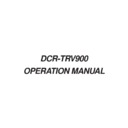Sony DCR-TRV900 Service Manual ▷ View online
13
2-2-2. Loading the Progressive Picture to Memory
(1) The video output signal from the camera block is stored in the DRAM (IC752)
as many as picture elements of one frame. The video signal is converted
here to the VGA (640
×
460) size.
(2) When the video signal equivalent to picture elements of one frame, is stored,
it is read by the HONEY (IC756).
(3) The read-out data is sent to the JPEG (IC757).
(4) The data is then compressed in the JPEG (IC757) and is sent to the DRAM
(IC758).
(5) The data from DRAM (IC758) is added by the header information and the
directory that are supplied from the DS controller I the PC card I/F (IC701).
The added information is stored in the PC card.
2-2-3. Reading the Progressive Picture from Memory to VFD
(6) The compressed data that is output from the PC card, takes the two paths.
The picture information only of the compressed data, is sent to the DRAM
(IC758). The header information and directory only of the compressed data,
is sent to the DS controller.
(7) The picture information is expanded by the JPEG (IC757).
(8) The read-out data from the PC card, is sent to the DRAM (IC752) through
the HONEY (IC756).
(9) The picture information is sent to the VFD (IC1501) through the HONEY
(IC756).
Signal processing block diagram of the still picture
(1)
IC756
HONEY
JPEG
DRAM (4M)
IC701
IC758
IC757
IC752
IC751
DRAM (16M)
(2)
(3)
(4)
(5)
(6)
DATA BUS
ADDRESS BUS
from CAM, BBI,
VFD
VFD
PC card I/F
(9)
(8)
(7)
IC1501
VFD
DS controller
(SH2)
Recording medium
(PC card)
14
2-3. New SteadyShot Function (Active Lens System)
Operating Principle
A part of the inner lens is attached to the movable frame as shown in Fig. 2-3-1.
The movable frame has the structure that a coil is wound around the other part
of the movable frame. When the inner lens is shaken, a current flows through
the coil whereas the coil can be moved as it is coupled with the magnet of the
opposite pole. Amount of shaking (movement) is detected as a part of the mov-
able frame moves inside the photo-interrupter (between IRED and PSD).
Features
(1) The optical system can be made compact.
(Compared with the active prism system)
(2) There is no deterioration of picture quality.
(Compared with the active image area system)
Fig. 2-3-1
Fig. 2-3-1
Fig. 2-3-3
PSD
Shift unit
Fixed frame
IRED
Sdrive_h
Spsd_h
Spsd_v
Sdrive_v
IRED
PSD
Horizontal
direction position
detection circuit
direction position
detection circuit
Vertical
direction position
detection circuit
direction position
detection circuit
Guide plate to prevent
the lens system
from rolling
the lens system
from rolling
Eccentric pin
Movable frame
Subject side
CCD side
Yoke
Magnet
Coil
Yoke
Slit
IRED
PSD
Horizontal
direction
drive coil
direction
drive coil
Vertical
direction
drive coil
direction
drive coil
Shift lens
Shift lens
Shift unit
Lens unit
CCD
Position of the shift lens after it is moved
Direction of movement of the shift lens
Subject side
Other lens group
Other lens group
Shaking of image
Corrected image
15
New SteadyShot Correction Circuit
(1) The camera-shake is detected by the yaw sensor (SE-450) and the pitch sensor
(SE-451). The detected signals are amplified by the yaw/pitch sensor ampli-
fier IC400 and are passed through a low-pass filter in order to isolate the de-
tection signal of the range from several Hz to several ten Hz. The detected
signal output from the low-pass filter, is A/D converted by IC302 so that the
digital camera-shake compensation signal is generated.
(2) The Y-PWM output signal from pin$¢ of IC302 and the P-PWM output signal
from pin$∞ of IC302, are supplied in the form of the PWM waveform. These
output signals are used to control the VAP drive (IC351, IC352) that activate
the active prism actuator.
16
2-4. New Imager
2-4-1. Dichroic Prism
A new dichroic prism is used in order to make the DCR-TRV900 compact includ-
ing the lens block. Feature of the new dichroic prism is that the red imager re-
ceives the direct light, the green imager is positioned in the lower side and the
blue imager is positioned in the upper side. Because the top and the bottom of the
blue image is inverted, the blue imager is installed with its top and bottom in-
verted
2-4-2. New 3-CCD Imager
[Interlaced mode]
The video signal is read out from the image sensor using the conventional method
of mixing the two pixels. (The video signal is read out once every vertical
field.)
[Progressive mode]
The video signal is read out from the image sensor once every two vertical
fields.
New 3-CCD Camera Systrm
B
R
G
Incident light
Vertical CCD
Image Sensor
Interlaced mode
Progressive mode
Quality is maintained.
S/N decreases.
Dual Mode CCD
Click on the first or last page to see other DCR-TRV900 service manuals if exist.

